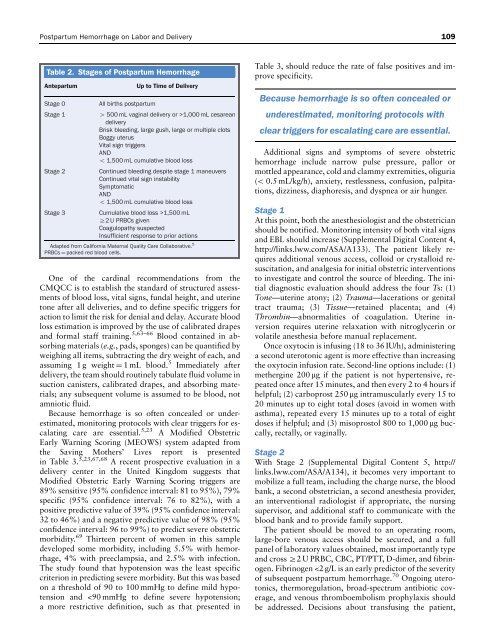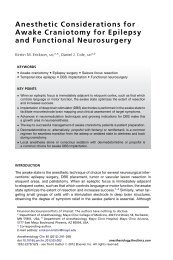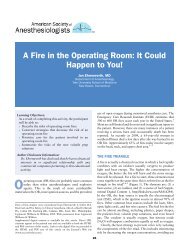14 Postpartum Hemorrhage on Labor and Delivery.pdf - Vtr
14 Postpartum Hemorrhage on Labor and Delivery.pdf - Vtr
14 Postpartum Hemorrhage on Labor and Delivery.pdf - Vtr
Create successful ePaper yourself
Turn your PDF publications into a flip-book with our unique Google optimized e-Paper software.
<str<strong>on</strong>g>Postpartum</str<strong>on</strong>g> <str<strong>on</strong>g>Hemorrhage</str<strong>on</strong>g> <strong>on</strong> <strong>Labor</strong> <strong>and</strong> <strong>Delivery</strong><br />
Table 2. Stages of <str<strong>on</strong>g>Postpartum</str<strong>on</strong>g> <str<strong>on</strong>g>Hemorrhage</str<strong>on</strong>g><br />
Antepartum Up to Time of <strong>Delivery</strong><br />
Stage 0 All births postpartum<br />
Stage 1 4 500 mL vaginal delivery or >1,000 mL cesarean<br />
delivery<br />
Brisk bleeding, large gush, large or multiple clots<br />
Boggy uterus<br />
Vital sign triggers<br />
AND<br />
o 1,500 mL cumulative blood loss<br />
Stage 2 C<strong>on</strong>tinued bleeding despite stage 1 maneuvers<br />
C<strong>on</strong>tinued vital sign instability<br />
Symptomatic<br />
AND<br />
o 1,500 mL cumulative blood loss<br />
Stage 3 Cumulative blood loss >1,500 mL<br />
Z2 U PRBCs given<br />
Coagulopathy suspected<br />
Insufficient resp<strong>on</strong>se to prior acti<strong>on</strong>s<br />
Adapted from California Maternal Quality Care Collaborative. 5<br />
PRBCs ¼ packed red blood cells.<br />
One of the cardinal recommendati<strong>on</strong>s from the<br />
CMQCC is to establish the st<strong>and</strong>ard of structured assessments<br />
of blood loss, vital signs, fundal height, <strong>and</strong> uterine<br />
t<strong>on</strong>e after all deliveries, <strong>and</strong> to define specific triggers for<br />
acti<strong>on</strong> to limit the risk for denial <strong>and</strong> delay. Accurate blood<br />
loss estimati<strong>on</strong> is improved by the use of calibrated drapes<br />
<strong>and</strong> formal staff training. 5,63–66 Blood c<strong>on</strong>tained in absorbing<br />
materials (e.g., pads, sp<strong>on</strong>ges) can be quantified by<br />
weighing all items, subtracting the dry weight of each, <strong>and</strong><br />
assuming 1 g weight ¼ 1 mL blood. 5 Immediately after<br />
delivery, the team should routinely tabulate fluid volume in<br />
sucti<strong>on</strong> canisters, calibrated drapes, <strong>and</strong> absorbing materials;<br />
any subsequent volume is assumed to be blood, not<br />
amniotic fluid.<br />
Because hemorrhage is so often c<strong>on</strong>cealed or underestimated,<br />
m<strong>on</strong>itoring protocols with clear triggers for escalating<br />
care are essential. 5,23 A Modified Obstetric<br />
Early Warning Scoring (MEOWS) system adapted from<br />
the Saving Mothers’ Lives report is presented<br />
in Table 3. 5,23,67,68 A recent prospective evaluati<strong>on</strong> in a<br />
delivery center in the United Kingdom suggests that<br />
Modified Obstetric Early Warning Scoring triggers are<br />
89% sensitive (95% c<strong>on</strong>fidence interval: 81 to 95%), 79%<br />
specific (95% c<strong>on</strong>fidence interval: 76 to 82%), with a<br />
positive predictive value of 39% (95% c<strong>on</strong>fidence interval:<br />
32 to 46%) <strong>and</strong> a negative predictive value of 98% (95%<br />
c<strong>on</strong>fidence interval: 96 to 99%) to predict severe obstetric<br />
morbidity. 69 Thirteen percent of women in this sample<br />
developed some morbidity, including 5.5% with hemorrhage,<br />
4% with preeclampsia, <strong>and</strong> 2.5% with infecti<strong>on</strong>.<br />
The study found that hypotensi<strong>on</strong> was the least specific<br />
criteri<strong>on</strong> in predicting severe morbidity. But this was based<br />
<strong>on</strong> a threshold of 90 to 100 mmHg to define mild hypotensi<strong>on</strong><br />
<strong>and</strong>




